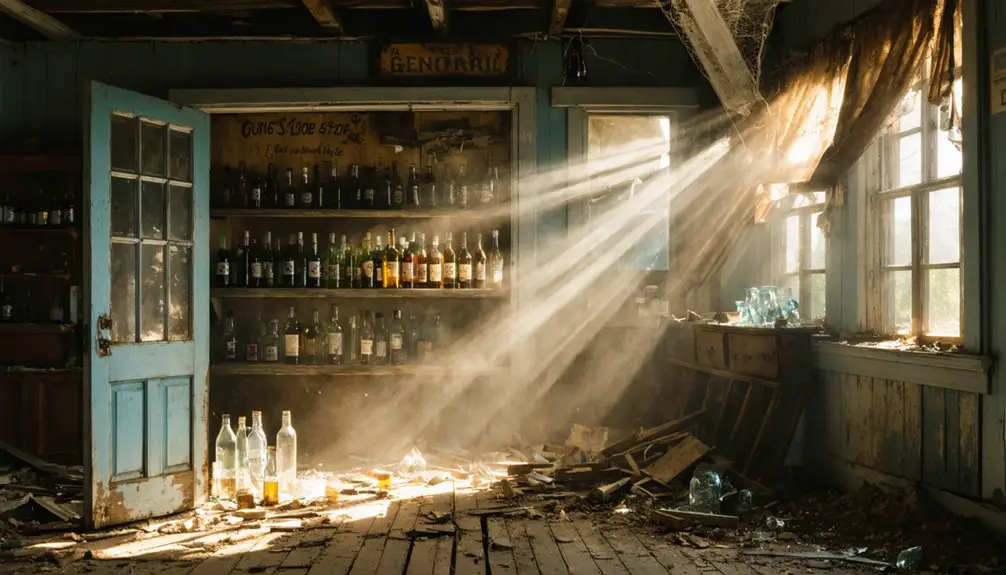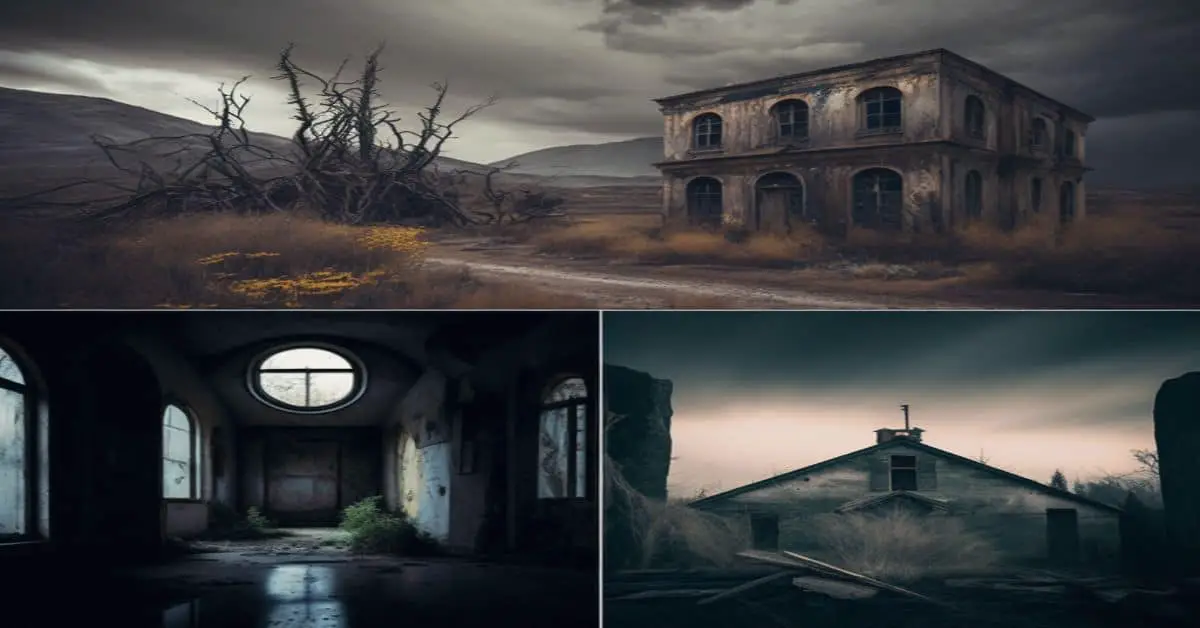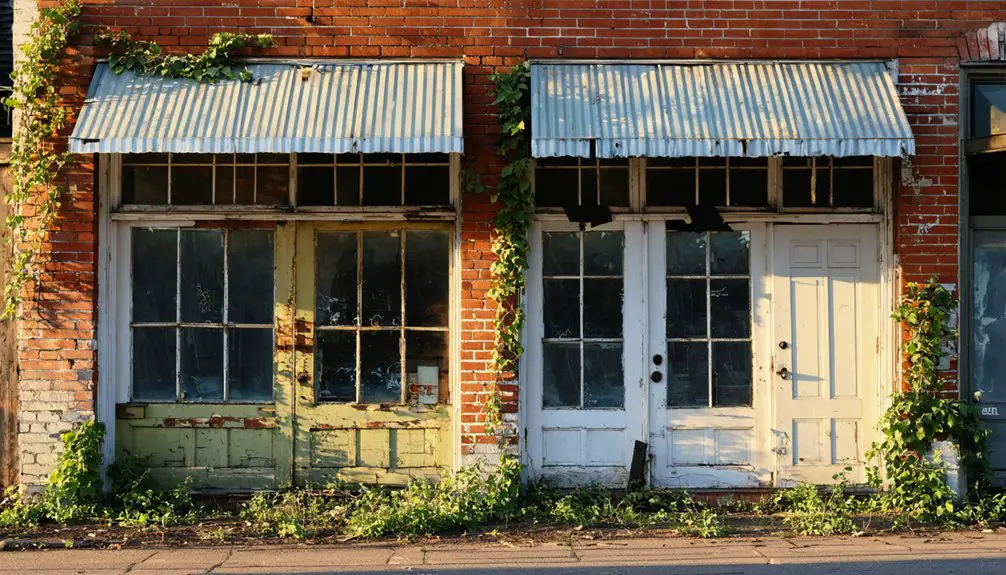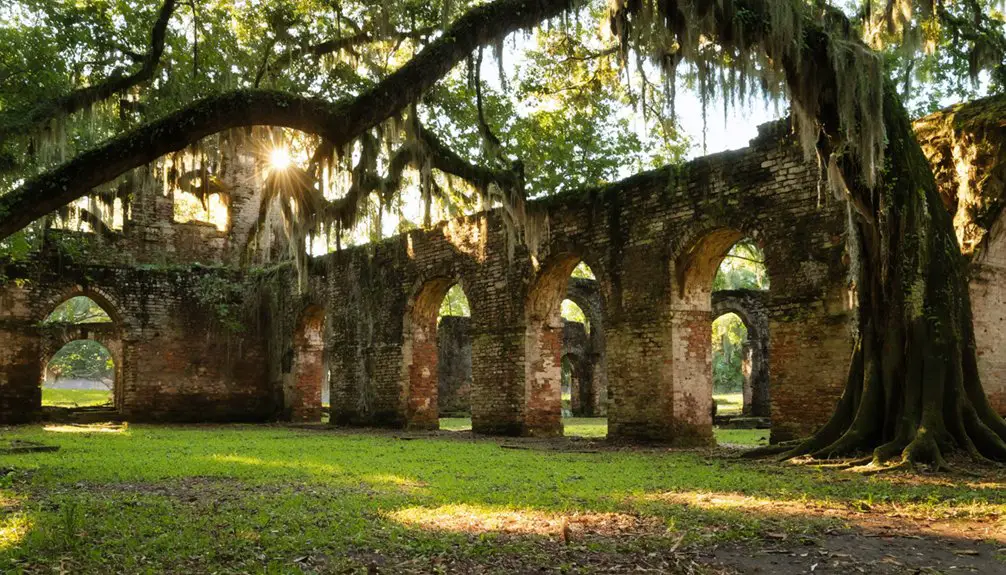You’ll find Whitney, North Carolina beneath the waters of Badin Lake, where a once-thriving riverside community thrived before its submersion in 1915. The town developed during post-Civil War years along the Yadkin River, featuring homes, a general store, church, and schools. L’Aluminium Français’s acquisition led to the Narrows Dam project, which flooded the town. During low water seasons, you can still spot structural remnants of mill houses and industrial foundations emerging from the depths.
Key Takeaways
- Whitney was a thriving North Carolina settlement that was submerged underwater in 1915 following the completion of Badin Dam.
- The town emerged during post-Civil War development, featuring a general store, church, schools, and homes along strategic waterways.
- Residents relied on timber, agriculture, and moonshine production before the area’s transformation into an industrial aluminum production site.
- Structural remnants of Whitney’s buildings occasionally become visible during low water periods in modern-day Badin Lake.
- The town’s history is preserved through local oral traditions, historical societies, and museums that document its submersion and cultural legacy.
The Birth of a Riverside Community
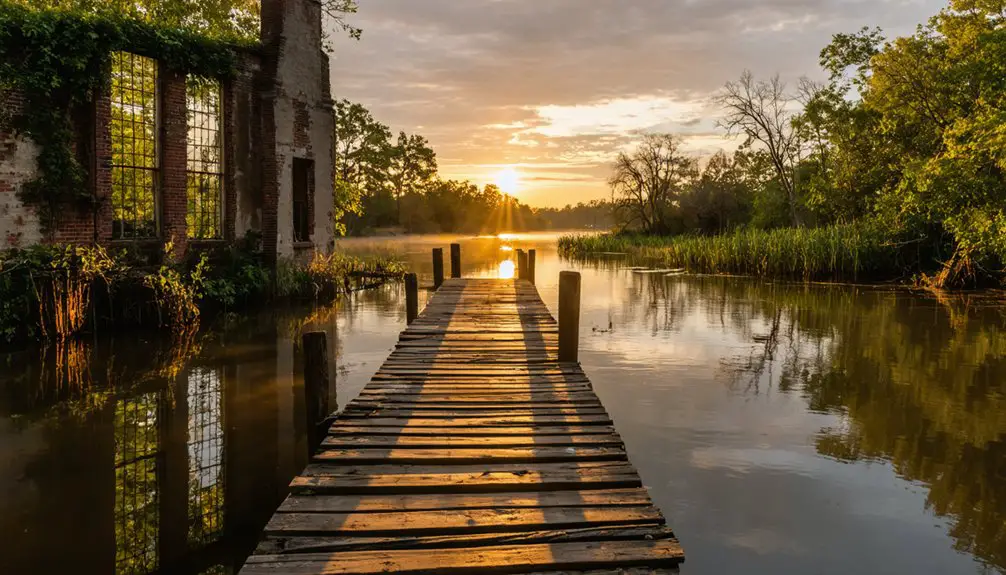
As the post-Civil War era ushered in new opportunities for development across North Carolina, the riverside settlement of Whitney emerged along a strategic waterway that would shape its destiny.
You’ll find that early settlers strategically positioned their homes and basic infrastructure near the river’s edge, capitalizing on abundant timber and land resources that sustained their growing community. Like many communities during this period, moonshine production became a significant source of income for residents. The Oregon Lumber Company established a major logging operation that would define the town’s economic foundation.
The town’s lifeblood centered on river commerce, with a general store, church, and schools springing up to serve families drawn to the water’s promise.
Community events often revolved around seasonal harvests and riverside gatherings, fostering tight-knit relationships among residents.
Along the river’s edge, neighbors celebrated bountiful harvests together, weaving enduring bonds through shared traditions and seasonal festivities.
You can trace Whitney’s modest but steady growth through the late 19th century, as river-based trade and transportation created essential connections to broader markets and neighboring settlements.
Industrial Development and the Aluminum Plant
You’ll find that Whitney’s industrial story shifted dramatically when L’Aluminium Français acquired the defunct Whitney Dam project in 1912, choosing to relocate operations to the Narrows site for greater hydroelectric potential.
When Alcoa took over in 1915, they quickly completed the Narrows Dam and Badin Works aluminum smelting plant, establishing a powerful industrial presence that would shape the region’s future.
The facility’s growing power needs led to the construction of additional dams – Falls (1919), High Rock (1927), and Tuckertown (1962) – creating an extensive hydroelectric network that supported decades of aluminum production.
Power Generation Needs
When L’Aluminium Français acquired the Whitney assets in 1912, the company strategically selected the Narrows site on the Yadkin River for its ambitious power generation project.
You’ll find that the site’s natural geography proved perfect for energy efficiency, with the river narrowing to less than 100 feet through a steep gorge.
The French company’s subsidiary, Southern Aluminum Company, began constructing a 200-foot dam in 1913 to power their aluminum smelting operations.
This infrastructure sustainability project was essential, as aluminum production demands massive amounts of electricity. The hydroelectric plant would eventually support production of up to 125,000 tons of aluminum annually.
The power generation capabilities were so substantial that they enabled the creation of Badin village, supporting roughly 3,000 workers with extensive company-controlled utilities and facilities.
Construction and Infrastructure Development
The construction of Southern Aluminum Company‘s industrial complex marked a significant advancement in North Carolina’s manufacturing capabilities.
Drawing from earlier factory innovations pioneered by industrial sites like Whitney’s Connecticut plant, the aluminum facility integrated modern machine tools and precision manufacturing methods to establish efficient production systems.
You’ll find that the development transformed the local landscape, as workers’ housing and community facilities sprouted around the plant site.
The company built essential infrastructure including transportation routes for raw materials and finished products, mirroring the logistics systems that had proven successful in earlier industrial developments.
Labor dynamics shaped the community’s growth, with distinct housing areas emerging based on worker roles and skill levels.
The construction phase prioritized proximity to reliable power sources and transportation networks, essential elements for the plant’s ambitious production goals.
Aluminum Production Impact
Following its establishment in 1912, Southern Aluminum Company‘s massive industrial complex near Whitney revolutionized the region’s manufacturing landscape by harnessing hydroelectric power from the Yadkin River for aluminum smelting.
Under Alcoa’s later ownership, aluminum production peaked at 125,000 tons annually during World War II, making the facility a critical component of national defense manufacturing.
You’ll find the plant’s influence extended beyond industrial output – it created Badin, a company town housing 3,000 workers in European-style buildings.
While the operation brought economic prosperity, it also left lasting environmental contamination. PCB oils from the plant were used for dust control on unpaved roads, particularly in segregated areas like West Badin.
The facility’s near-monopoly on aluminum production shaped both the region’s economy and social structure throughout the mid-20th century.
The Badin Lake Project
If you’d visited the Yadkin River in 1912, you’d have witnessed L’Aluminium Francaise’s bold shift from the original Whitney Dam site to the more promising Narrows location, where engineers planned a towering 201-foot dam that would increase power capacity by 50 MW.
Construction challenges mounted as French workers departed during World War I in 1914, leaving the massive project half-finished until ALCOA’s takeover in 1915.
Your visit today reveals the successful completion of what became Badin Lake, a proof of early 20th-century engineering that transformed both the region’s industrial capacity and the lives of local residents who built their community around this ambitious hydroelectric project.
Dam Construction Timeline
During the early 1900s, construction of Whitney Dam marked the beginning of an ambitious hydroelectric project that would transform North Carolina’s Yadkin River Valley.
You’ll find the dam’s history began in 1901 when workers started building with granite blocks from Whitney Quarry, but the project went bankrupt by 1907 after losing $19 million.
In 1912, L’Aluminium Français acquired Whitney’s holdings and shifted construction several miles downstream to the Narrows site, planning a much larger dam.
When World War I interrupted French operations, Alcoa stepped in during 1915, completing the massive structure by 1917.
Despite a devastating flood in July 1916 that temporarily halted progress, they’d finished the world’s largest dam of its time – standing 220 feet high and generating essential hydroelectric power for the region’s aluminum industry.
Engineering Challenges Faced
While the ambitious Badin Lake Project promised unprecedented hydroelectric power for North Carolina’s emerging aluminum industry, engineers faced formidable challenges at every turn.
You’ll find that overcoming the rugged Uwharrie Mountain terrain required innovative solutions, including a dedicated railroad line just to transport massive granite blocks 20 miles from Whitney Quarry.
The engineering innovations didn’t stop there. The project demanded scaling up from a modest 38-foot dam to a towering 201-foot structure at the Narrows, forcing engineers to completely rethink structural integrity concerns.
They’d to tackle immense water pressure issues, bedrock stability, and construct a complex 5-mile diversion canal.
Early 20th-century technology limitations and World War I’s disruption of French engineering expertise further complicated this massive undertaking.
Local Community Impact
The engineering triumphs of the Badin Lake Project cast a long shadow over local communities, particularly in West Badin’s largely Black neighborhoods.
You’ll find a stark legacy of environmental racism, where decades of industrial operations led to persistent soil and water contamination, disproportionately affecting these residents’ community health.
Since 2013, you’ve seen grassroots resistance emerge through organizations like Concerned Citizens of West Badin, partnering with the Southern Environmental Law Center and Yadkin Riverkeeper to demand accountability.
While Alcoa’s operations once provided jobs, they’ve left behind toxic sites that continue to plague the region.
Despite some remediation efforts under RCRA regulations, including waste area cleanup and stormwater management systems, the community still grapples with ongoing pollution concerns that affect their economic opportunities and quality of life.
Life Before the Waters Rose
Before rising waters claimed Whitney, North Carolina, this small but vibrant community thrived along the Yadkin River through a diverse economic foundation of aluminum production, hydroelectric power, logging, and moonshining activities.
You’d have found a tight-knit society where workers and their families built their lives around the industrial heartbeat of the hydroelectric dam and aluminum plant. The community dynamics reflected both traditional Southern Appalachian culture and the newer industrial workforce lifestyle. Like the town of Whitney in Oregon, this settlement played a vital role in supplying goods to surrounding communities.
Economic influences shaped daily routines, with many residents working in the nearby facilities while others sustained themselves through logging or moonshining in the surrounding forests.
The town’s infrastructure supported its working population with basic amenities, though specific records of schools and churches remain scarce in historical documents.
The Great Submersion
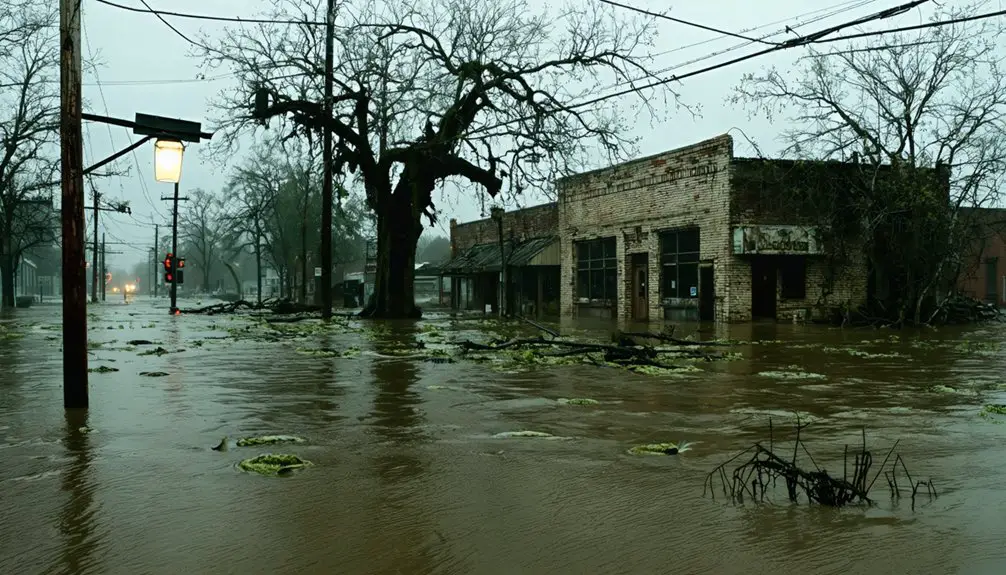
During 1901, ambitious plans to harness the Yadkin River’s power launched Whitney’s transformation from riverside settlement to submerged ghost town. The project’s bankruptcy in 1907 left $19 million in losses and an unfinished granite dam, marking the first chapter of Whitney’s descent into submerged history.
Whitney’s bold hydroelectric dream crumbled into bankruptcy, leaving behind $19 million in losses and an unfinished dam’s ghostly remains.
When ALCOA completed Badin Dam in 1915, the rising waters of what would become Badin Lake erased the landscape you would’ve recognized.
The Narrows disappeared beneath the flood, taking with them Whitney’s forgotten landscapes – the original dam site, settlements, and dreams of a thriving resort town.
Today, you’ll find these remnants of Whitney’s past hidden beneath the reservoir’s surface, only visible during extremely low water levels, a silent reminder of the town’s ambitious beginnings and watery end.
What Remains Today
While much of Whitney lies beneath Badin Lake‘s waters, scattered remnants of this once-ambitious town still emerge along the shoreline today.
You’ll find structural remnants of mill houses and industrial foundations peeking through the waterline during low water seasons, with archaeological artifacts occasionally surfacing nearby.
Nature has steadily reclaimed Whitney’s exposed remains, creating an ethereal landscape where past meets present.
If you venture to explore these ghostly ruins, you’ll discover:
- Concrete footings and building foundations visible near the shoreline
- Original road segments and bridge remnants around the lake’s edge
- Historic markers detailing Whitney’s significance
- Scattered industrial equipment and household items among overgrown vegetation
Access requires careful navigation by boat or hiking through unstable terrain, as no formal tourism infrastructure exists at the site.
The ruins serve as silent witnesses to Whitney’s industrial heritage.
Legacy and Local Memory
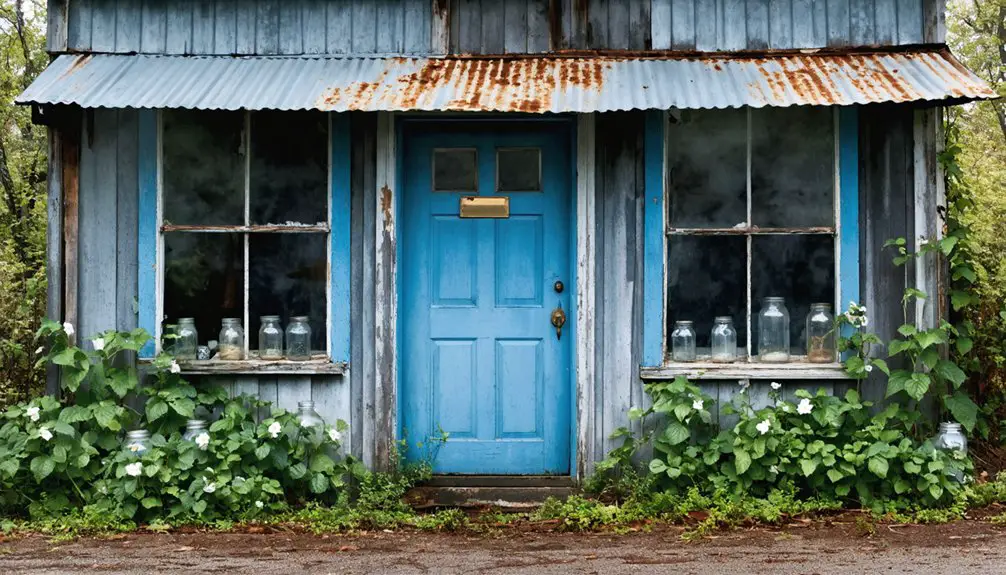
How does a town’s memory persist when its streets lie beneath the waters? Whitney’s legacy lives on through oral histories passed down by former residents and their descendants.
You’ll find the town’s story woven into local folklore, highlighting themes of community resilience and economic transformation. The flooding of Whitney for hydroelectric power represents a pivotal moment in North Carolina’s industrial heritage, where progress came at the cost of displacement.
Today, historical societies and museums preserve Whitney’s cultural legacy through artifacts and documented accounts. Local historians emphasize the environmental consequences of the dam’s creation while acknowledging the crucial role it played in regional development.
Whitney’s underwater legacy lives on through preserved artifacts, while historians balance the dam’s environmental impact with its developmental necessity.
The town’s story serves as a powerful reminder of how industrial priorities reshaped communities, making Whitney’s historical remembrance essential to understanding North Carolina’s evolving landscape.
Visiting Whitney’s Ghost Waters
Three distinct paths lead visitors to Whitney’s watery remains: by boat across Badin Lake, along remnant shoreline trails, or from elevated vantage points in surrounding areas.
You’ll find ghostly remnants of this once-thriving town beneath the lake’s surface, where industrial progress claimed the settlement for hydroelectric power.
- Access requires careful planning – bring a watercraft or arrange boat transportation
- Best visibility occurs during low water seasons when submerged history emerges
- Explore foundations and structural remains along the shoreline with caution
- Pack cameras and local maps, as formal signage doesn’t mark historical spots
Consider seasonal water levels when timing your visit.
The lake’s recreational activities now dominate where Whitney once stood, but patient explorers can still glimpse traces of the past beneath these transformed waters.
Frequently Asked Questions
What Wildlife Now Inhabits the Submerged Areas of Whitney?
While fish dart through sunken buildings, you’ll find remarkable wildlife diversity in Whitney’s submerged ecosystems: bass, catfish, turtles, frogs, salamanders, crayfish, and various aquatic insects thrive beneath the surface.
Were Any Artifacts Recovered From Homes Before the Flooding?
You won’t find documented evidence of artifact preservation efforts before Whitney’s flooding, though historical significance suggests items likely existed. Local ghost towns indicate artifacts were probably present but went unrecovered.
Do Any Former Whitney Residents Still Live in Nearby Communities?
Like ripples in still water, you’ll find former residents’ stories echo through nearby towns, but there’s no definitive record of who stayed local – just scattered local stories passed between generations.
What Was the Population of Whitney at Its Peak?
You’ll find Whitney’s history quite elusive – no precise peak population records exist, but based on similar North Carolina ghost towns’ patterns and population decline, it likely peaked at 100-300 residents.
Are There Any Annual Events Commemorating Whitney’s History?
You won’t find any annual events commemorating Whitney’s historical significance. Despite the region’s rich heritage, there’s no organized community engagement or regular celebrations specifically dedicated to Whitney’s ghost town past.
References
- https://www.onlyinyourstate.com/experiences/north-carolina/nc-ghost-towns
- https://www.youtube.com/watch?v=KwOQ_Z0MOlU
- https://en.wikipedia.org/wiki/List_of_ghost_towns_in_North_Carolina
- https://www.youtube.com/watch?v=D3J3qskaiYY
- https://kids.kiddle.co/List_of_ghost_towns_in_North_Carolina
- https://en.wikipedia.org/wiki/Ghost_Town_Village
- https://en.wikipedia.org/wiki/Alcoa_Power_Generating
- https://www.salisburypost.com/2015/09/06/history-of-badin-recorded-in-new-book/
- https://www.renewableenergyworld.com/hydro-power/hydro-review-narrows-hydropower-plant-generating-clean-energy-since-1917/
- https://cubecarolinas.com/history/
